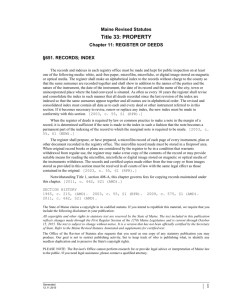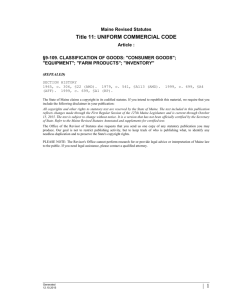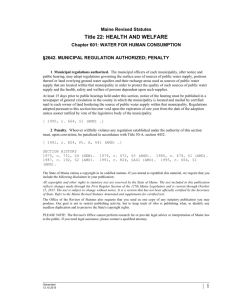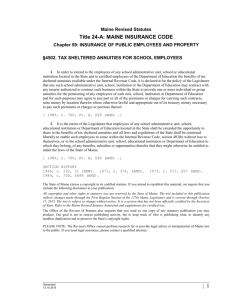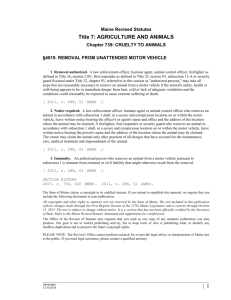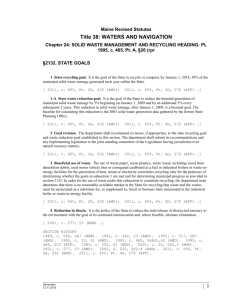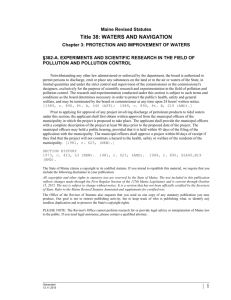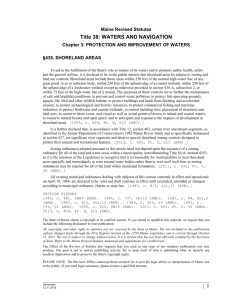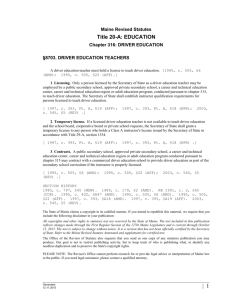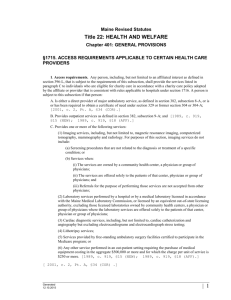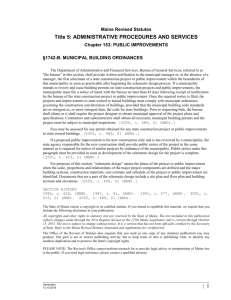703 MS-Word - Maine Legislature
advertisement
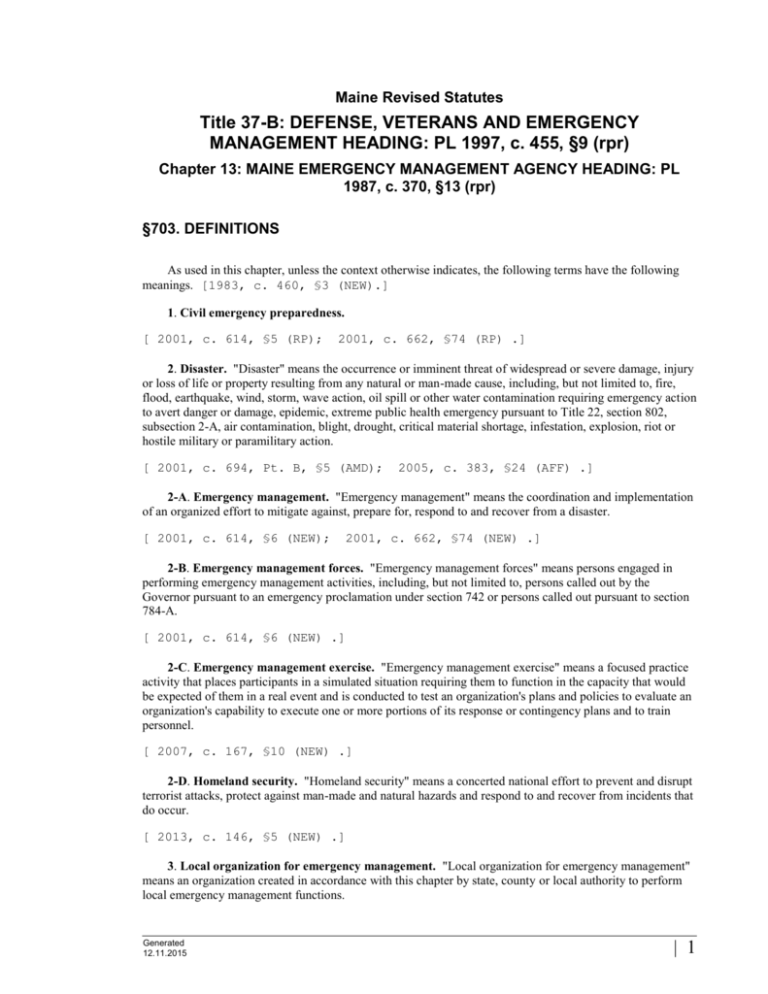
Maine Revised Statutes Title 37-B: DEFENSE, VETERANS AND EMERGENCY MANAGEMENT HEADING: PL 1997, c. 455, §9 (rpr) Chapter 13: MAINE EMERGENCY MANAGEMENT AGENCY HEADING: PL 1987, c. 370, §13 (rpr) §703. DEFINITIONS As used in this chapter, unless the context otherwise indicates, the following terms have the following meanings. [1983, c. 460, §3 (NEW).] 1. Civil emergency preparedness. [ 2001, c. 614, §5 (RP); 2001, c. 662, §74 (RP) .] 2. Disaster. "Disaster" means the occurrence or imminent threat of widespread or severe damage, injury or loss of life or property resulting from any natural or man-made cause, including, but not limited to, fire, flood, earthquake, wind, storm, wave action, oil spill or other water contamination requiring emergency action to avert danger or damage, epidemic, extreme public health emergency pursuant to Title 22, section 802, subsection 2-A, air contamination, blight, drought, critical material shortage, infestation, explosion, riot or hostile military or paramilitary action. [ 2001, c. 694, Pt. B, §5 (AMD); 2005, c. 383, §24 (AFF) .] 2-A. Emergency management. "Emergency management" means the coordination and implementation of an organized effort to mitigate against, prepare for, respond to and recover from a disaster. [ 2001, c. 614, §6 (NEW); 2001, c. 662, §74 (NEW) .] 2-B. Emergency management forces. "Emergency management forces" means persons engaged in performing emergency management activities, including, but not limited to, persons called out by the Governor pursuant to an emergency proclamation under section 742 or persons called out pursuant to section 784-A. [ 2001, c. 614, §6 (NEW) .] 2-C. Emergency management exercise. "Emergency management exercise" means a focused practice activity that places participants in a simulated situation requiring them to function in the capacity that would be expected of them in a real event and is conducted to test an organization's plans and policies to evaluate an organization's capability to execute one or more portions of its response or contingency plans and to train personnel. [ 2007, c. 167, §10 (NEW) .] 2-D. Homeland security. "Homeland security" means a concerted national effort to prevent and disrupt terrorist attacks, protect against man-made and natural hazards and respond to and recover from incidents that do occur. [ 2013, c. 146, §5 (NEW) .] 3. Local organization for emergency management. "Local organization for emergency management" means an organization created in accordance with this chapter by state, county or local authority to perform local emergency management functions. Generated 12.11.2015 | 1 MRS Title 37-B §703. DEFINITIONS [ 2001, c. 614, §7 (AMD); 2001, c. 662, §74 (AMD) .] 3-A. Mitigation. "Mitigation" means those activities that actually eliminate or reduce the chance of occurrence or the effects of a disaster. [ 2001, c. 662, §74 (NEW) .] 4. Political subdivision. "Political subdivision" means counties, cities, towns, villages, townships, districts, authorities and other public corporations and entities organized and existing under charter or general law. [ 1983, c. 460, §3 (NEW) .] 5. Preparedness. "Preparedness" means planning how to respond in case an emergency or disaster occurs and working to increase resources available to respond effectively. [ 2001, c. 662, §74 (NEW) .] 6. Recovery. "Recovery" means activities that, in the short term, return vital life support systems to minimum operating standards and, in the long term, redevelop a disaster area to preexisting conditions or to conditions that are less disaster prone and activities that assist families and businesses to return to a normal or improved state of being. [ 2001, c. 662, §74 (NEW) .] 7. Response. "Response" means those activities designed to provide emergency assistance to victims of a disaster and reduce the likelihood of secondary damage. [ 2001, c. 662, §74 (NEW) .] 8. Terrorism. "Terrorism" means conduct that is designed to cause serious bodily injury or substantial risk of bodily injury to multiple persons, substantial damage to multiple structures whether occupied or unoccupied or substantial physical damage sufficient to disrupt the normal functioning of a critical infrastructure. [ 2013, c. 146, §6 (NEW) .] SECTION HISTORY 1983, c. 460, §3 (NEW). 1997, c. 580, §1 (AMD). 2001, c. 614, §§5-7 (AMD). 2001, c. 662, §74 (AMD). 2001, c. 694, §B5 (AMD). 2001, c. 694, §B6 (AFF). 2003, c. 366, §1 (AFF). 2005, c. 383, §24 (AFF). 2007, c. 167, §10 (AMD). 2013, c. 146, §§5, 6 (AMD). The State of Maine claims a copyright in its codified statutes. If you intend to republish this material, we require that you include the following disclaimer in your publication: All copyrights and other rights to statutory text are reserved by the State of Maine. The text included in this publication reflects changes made through the First Regular Session of the 127th Maine Legislature and is current through October 15, 2015. The text is subject to change without notice. It is a version that has not been officially certified by the Secretary of State. Refer to the Maine Revised Statutes Annotated and supplements for certified text. The Office of the Revisor of Statutes also requests that you send us one copy of any statutory publication you may produce. Our goal is not to restrict publishing activity, but to keep track of who is publishing what, to identify any needless duplication and to preserve the State's copyright rights. PLEASE NOTE: The Revisor's Office cannot perform research for or provide legal advice or interpretation of Maine law to the public. If you need legal assistance, please contact a qualified attorney. | 2 Generated 12.11.2015

